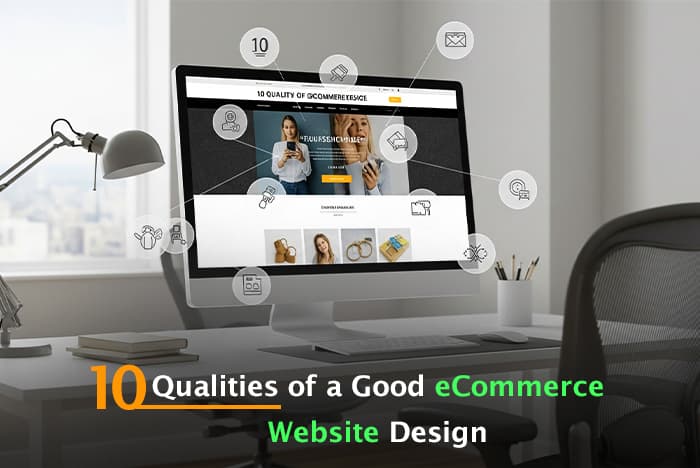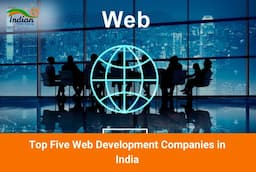The 10 Essential Qualities of a High-Converting eCommerce Website

The online market in 2025 is a dynamic competitive market and the most important thing to have a successful business in the Internet is a very well-designed e-commerce Website. It is more of an interactive online shop window through which visitors are captured, engaged and transformed to become regular buyers. In the world that is characterized by a hyperbole of user expectation, an online presence is not enough.
The effective eCommerce Website Design is a perfect combination of real-life strategy, combining both beauty and usability, technical prowess, and psychological appeal. Getting to know the fundamentals of what such design is all about is central to the need to attain online success.
The good eCommerce Website Design Qualities
1. Easy Navigator and User Experience (UX)
Easy navigation is the secret behind any good e-commerce site. One should not get lost or frustrated when trying to find something, the reason to do it is that people must find quickly and easily what they are looking for.
Effective Information Architecture: Naming of the products must be done clearly and descriptively. The user must know his position within the site at every point (breadcrumbs are very good).
Easily Noticeable Search Bar: Auto-suggest and filtering bar is important to users who recognize what they need, it should be very visible and functional.
Clean Menus: Menus (main navigation, mega menus, filter menus) must be clear and properly presented to visitors even those who are interacting with their business for the first time.
Familiar Guides: Use standard e-commerce patterns (e.g. cart icon top right, logo top left) as a way to make the user feel comfortable.
Minimal Clicks: Eliminate the number of clicks needed to make a purchase particularly those that are involved in the checkout process.
Whether it is entering a house or going through an eCommerce Website on the Web, a smooth UX is directly proportional to the conversion rate and a low bounce rate in the age of the eCommerce Website.
2. Mobile-First Responsiveness
In 2025, a large chunk of online shopping is happening on mobile devices. If your website doesn’t seamlessly adapt to different screen sizes, you’re missing out on a big part of your potential customers.
Fluid Layouts: Your design should automatically adjust to fit desktops, tablets, and smartphones without sacrificing readability or functionality.
Touch-Friendly Elements: Make sure buttons, links, and forms are big enough and spaced out well for easy tapping on touchscreens.
Optimized Performance on Mobile: Mobile sites need to load quickly, even on slower networks. This means using optimized images, efficient code, and keeping scripts to a minimum.
Simplified Navigation for Mobile: Mobile menus often need to be streamlined (think hamburger menus) while still keeping access to important sections easy.
Neglecting mobile responsiveness is a serious mistake for any modern eCommerce website design.
Related Post: Is Shopify Good for Ecommerce Website? [Pros and Cons]
3. High-Quality Visuals and Consistent Branding
Visual appeal plays a crucial role in attracting and keeping online shoppers. Your website acts as your virtual storefront, so it should showcase your brand's quality and personality.
Professional Product Photography: High-resolution images from various angles, zoom features, and lifestyle shots are essential. Low-quality images can damage trust.
Consistent Branding: Your logo, color scheme, typography, and overall visual style should be uniform across the entire site and all marketing materials. This helps build recognition and trust.
Engaging Videos: Product videos, testimonials, or brand stories can significantly enhance engagement and boost conversion rates.
Clean and Modern Aesthetics: A tidy design with plenty of white space makes content easier to digest and gives a premium feel.
A skilled eCommerce website design company India will focus on visual storytelling and brand consistency in their design strategy.
4. Optimized Product Pages
Product pages are where the magic of conversion truly happens. They need to be engaging, informative, and persuasive.
Detailed & Persuasive Product Descriptions: Don’t just list features; emphasize the benefits, address customer pain points, and use captivating language. And don’t forget to optimize for SEO!
Clear Pricing & Availability: Make sure the price stands out, and any discounts or special offers are easy to spot. Real-time stock indicators can be a great help too.
Customer Reviews & Ratings: Social proof is a powerful tool. Make sure to showcase reviews prominently and allow customers to submit their feedback easily.
Clear Call-to-Action (CTA): The "Add to Cart" or "Buy Now" button should be eye-catching, easy to click, and clearly communicate its purpose.
Related Products/Upsells/Cross-sells: Strategically recommend complementary or upgraded products to boost the average order value (AOV).
Technical Specifications & Sizing Guides: Provide all the necessary details for complex products (like electronics) or clothing.
Related Post: How to Choose a Domain Name for eCommerce Website
5. Seamless and Secure Checkout Process
A clunky or insecure checkout experience is the top reason for abandoned carts. This final step needs to be smooth and hassle-free.
Guest Checkout Option: Don’t make users create an account right away; offer it as an option after they’ve made a purchase.
Minimal Steps & Progress Indicator: Keep the number of form fields to a minimum and clearly show users how far along they are in the checkout process.
Trust Signals: Display security badges (like SSL and PCI DSS compliance), accepted payment logos, and customer support contact info.
Error Validation: Provide clear, real-time error messages for any invalid inputs to help guide users.
Abandoned Cart Recovery: Set up email or SMS campaigns to remind users about items they’ve left in their cart.
Multiple Payment Options: Offer a range of popular payment methods (credit/debit cards, net banking, UPI, digital wallets, EMI options) to accommodate different preferences.
6. Fast Loading Speed & Performance
In today’s world of instant gratification, slow-loading websites can really hurt e-commerce. Users want pages to pop up almost instantly.
Optimized Images: Make sure to compress images without losing quality, use modern formats like WebP, and consider lazy loading for better performance.
Minified Code: It’s essential to minify your HTML, CSS, and JavaScript files to keep file sizes down.
Leverage CDNs (Content Delivery Networks): Use servers that are closer to your users to deliver content faster.
Efficient Hosting: Pick a trustworthy hosting provider or e-commerce platform that’s known for its speed and reliability.
Reduced HTTP Requests: Cut down on the number of files (like scripts, stylesheets, and images) that the browser has to download.
An eCommerce Web Design company India will focus on technical optimization just as much as visual design to ensure a smooth and speedy user experience.
7. Strong SEO Foundation
A stunning website won’t do you any good if no one can find it. Great design should weave in SEO best practices from the very start.
Clean Code & Semantic HTML: Using well-structured HTML (with <header>, <nav>, <main>, <footer> tags, etc.) helps search engines grasp your content better.
Optimized URLs: Keep your URLs short, descriptive, and packed with relevant keywords.
Meta Titles & Descriptions: Craft unique and engaging meta titles and descriptions for each page.
Keyword Integration: Seamlessly weave relevant keywords into your product descriptions, category pages, and blog posts.
Schema Markup: Use structured data (like product schema and review schema) to help search engines show rich snippets in search results.
Blog/Content Section: Having a dedicated blog can attract organic traffic by offering valuable content related to your products and industry.
8. Effective Customer Support & Communication Channels
To build trust and loyalty, you need customer support that’s easy to access and quick to respond.
Clear Contact Information: Make sure your phone numbers, email addresses, or contact forms are easy to find.
Live Chat/Chatbots: Provide instant help for quick questions. AI-powered chatbots can tackle FAQs 24/7, ensuring your customers always have support when they need it.
Creating a Comprehensive FAQ Page: By addressing common questions upfront, you can lighten the support load significantly.
Order Tracking: Make it easy for customers to keep an eye on their shipments.
Social Media Integration: Share links to your social media channels to offer extra support and boost engagement.
9. User-Generated Content & Social Proof
Tapping into your customers' experiences can be a powerful persuasion tool.
Customer Reviews & Ratings: These are absolutely essential, as previously mentioned.
Testimonials: Shine a spotlight on the positive feedback from happy customers.
User-Generated Photos/Videos: Encourage your customers to post pictures of themselves using your products (think Instagram hashtags) and feature these on your website.
Social Media Feeds: Embed relevant social media feeds on your product pages or homepage to showcase your brand's activity and community engagement.
10. Strong Security Features
Building trust is crucial in the world of e-commerce. Customers need to feel safe when sharing their personal and financial details.
SSL Certificate (HTTPS): This is key for encrypting data that moves between the user's browser and your server, and it shows that reassuring padlock icon in the browser.
PCI DSS Compliance: If you're handling credit card information directly, make sure you're compliant with the Payment Card Industry Data Security Standard. Most trustworthy payment gateways take care of this for you.
Fraud Detection: Set up systems to spot and prevent fraudulent transactions.
Regular Backups: Keep your website data backed up on a regular basis.
Firewalls & Malware Scans: Safeguard your server against malicious attacks.
Many professional eCommerce website design India services will include strong security measures as a standard part of their offerings.
Related Post: How Much Does an eCommerce Website Development Cost in India?
Conclusion
A truly effective eCommerce Website Design is a strategic symphony of aesthetics, usability, and underlying technology. It's about crafting an online experience that not only looks professional but also functions flawlessly, builds trust, and ultimately drives sales.
By prioritizing intuitive navigation, mobile responsiveness, compelling visuals, optimized product pages, seamless checkout, blistering speed, strong SEO, excellent customer support, social proof, and unyielding security, businesses can build digital storefronts that not only stand out in the crowded online marketplace but also consistently convert visitors into valuable, long-term customers. For many, partnering with a specialized website design company India can be the key to expertly integrating these crucial qualities and achieving online success.
Recent Blogs

Web App vs Mobile App Development: Where You Invest?

Top Five Web Development Companies in India
